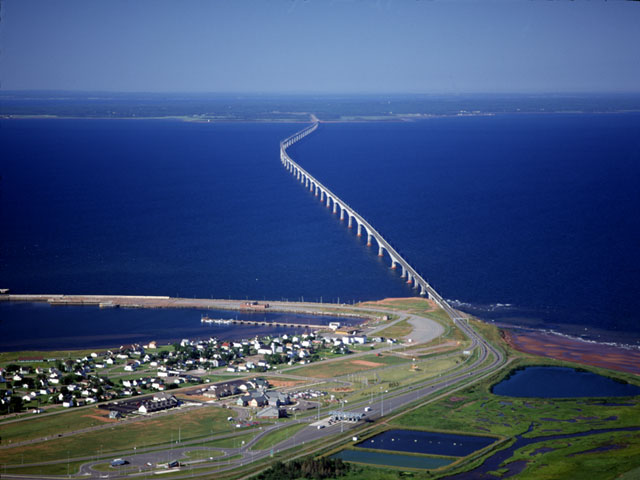 |
| The Confederation Bridge, an example of a sensor-equipped smart structure. |
As bridges and other structures, such as buildings age, it is natural that they develop cracks, concrete deterioration, and steel corrosion that can affect their safety or structural integrity. Using wireless sensor systems enables remote damage detection and structural health monitoring for bridges and other structures. The wireless bridge inspection device, applied directly to bridge surfaces, measures electrical impedance to detect changes in the condition of the bridge, such as steel corrosion and concrete deterioration. The device sends an electrical current through the material at set times each day, and the multi-channel impedance analyzer measures the material response over time and transmits data to the monitoring and data gathering site via the wireless data-link, thereby providing low cost, ongoing, automated structural health monitoring.
Wireless, automated impedance measurements applications includes:
- Used material characterization,
- Structural Health Monitoring (SHM),
- Electrical impedance tomography,
- Electrical impedance spectroscopy,
- “sensing skin” thin film composite,
- Bridge inspections and safety,
- Presence of flood, liquid detection in data centers.
Thermal radiation is a form of electromagnetic radiation with wavelengths longer than those of visible light. All objects above absolute zero temperature (0 K, –459.67°F) emit infrared radiation with an intensity that is proportional to the fourth power of the absolute temperature. In other words, as an object changes temperature, the amount of radiation it emits changes significantly. Of importance is the fact that all objects also have some degree of thermal reflectivity as a characteristic of their surface. Thermography is a technique that measures surface temperatures by using thermal infrared video and still cameras. These tools see light that falls within the heat spectrum. Images on the video or film record the temperature variations of the building's skin, ranging from bright for warm regions to dark for cooler areas. The resulting images help the building energy inspector to determine if insulation is needed. They also serve as a quality control tool to ensure that insulation has been installed correctly. Sensor platforms are also deployed to detect the presence of flood and liquids in data centers, warehouses and sensitive building grounds to prevent breakdowns and corrosion.
Research within the Center in the area of remotely monitoring buildings, bridges and the condition of historical monuments focuses on the following topics:
- Sensor platforms that are deployed to detect the presence of flood and liquids in data centers, warehouses and sensitive building grounds to prevent breakdowns and corrosion,
- Structural Health Monitoring using acoustic wave techniques,
- Detection of steel corrosion and concrete deterioration,
- Examining heat flow in buildings using thermography,
- Study of concrete building blocks’ thermal and fire resistant behavior,
- Prediction of structure holding time when subjected to fire (residence rescue time interval).

